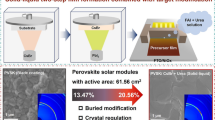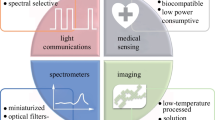Abstract
Unlike the conventional solution processable deposition techniques, in this study, we propose a novel and economical method for the fabrication of organic rectifying junctions. The solutions of the orange dye, copper phthalocyanine and NaCl were deposited on the surface-type interdigitated silver electrodes using electrolysis technique. Using the current–voltage (I–V) characteristics, the presence of rectifying behavior in the samples has been confirmed. This phenomenon, in principle, can be used for fabrication of the diodes, transistors and memory devices.




Similar content being viewed by others
References
E. Braun, S. MacDonald, Revolution in Miniature: the History and Impact of Semiconductor Electronics (Cambridge University Press, 1982)
T. Minari, C. Liu, M. Kano, K. Tsukagoshi, Controlled self-assembly of organic semiconductors for solution-based fabrication of organic field-effect transistors. Adv. Mater. 24(2), 299–306 (2012). doi:10.1002/adma.201102554
T. Maruyama, Y. Osaki, Electrochromic properries of manganese oxide thin films prepared by chemical vapor deposition. J. Electrochem. Soc. 142(9), 3137–3141 (1995)
W.Y. William, J.C. Falkner, C.T. Yavuz, V.L. Colvin, Synthesis of monodisperse iron oxide nanocrystals by thermal decomposition of iron carboxylate salts. Chem. Commun. 20, 2306–2307 (2004)
G. Myburg, F. Auret, Influence of the electron beam evaporation rate of Pt and the semiconductor carrier density on the characteristics of Pt/n–GaAs Schottky contacts. J. Appl. Phys. 71(12), 6172–6176 (1992)
T. Ali, K.S. Karimov, K.M. Akhmedov, K. Kabutov, A. Farooq, Thermo photo-electrochemical effect in n-InP/aqueous solution of orange dye/C cell. Electron. Mater. Lett. 11(2), 259–265 (2015)
M.T.S. Chani, K.S. Karimov, S.B. Khan, A.M. Asiri, Fabrication and investigation of flexible photo-thermo electrochemical cells based on Cu/orange dye aqueous solution/Cu. Int. J. Electrochem. Sci. 10, 5694–5701 (2015)
Z. Ahmad, K.S. Karimov, N. Fatima, F. Touati, Flexible organic photo-thermogalvanic cell for low power applications. J. Mater. Sci. Mater. Electron. 27(3), 2442–2447 (2016)
M. Saleem, M. Sayyad, K. Kartmov, K. Kabutov, Photoelectric studies of n-InP/orange dye/ITO cell. J. Optoelectron. Adv. Mater. 18(1–2), 123–129 (2016)
K. Karimov, M. Saleem, M.M. Bashir, T. ALIa, Temperature sensitivity of Zn/orange dye aqueous solution/carbon cell. Optoelectron. Adv. Mater. Rapid Commun. 10(3–4), 205–208 (2016)
M.T.S. Chani, K.S. Karimov, F. Khalid, S. Abbas, M. Bhatty, Orange dye? Polyaniline composite based impedance humidity sensors. Chin. Phys. B 22(1), 010701 (2013)
K.S.K. Syed Abdul Moiz, M.M. Ahmed, Electrical Characterization of Novel Organic Semiconductor: Materials and Devices for Sensor Technology (VDM Verlag Dr. Müller, Saarbrucken, 2010)
R.O. Loutfy, J.H. Sharp, C.K. Hsiao, R. Ho, Phthalocyanine organic solar cells: indium/x-metal free phthalocyanine Schottky barriers. J. Appl. Phys. 52(8), 5218–5230 (1981). doi:10.1063/1.329425
K.S. Karimov, M. Ahmed, S. Moiz, M. Fedorov, Temperature-dependent properties of organic-on-inorganic Ag/p-CuPc/n-GaAs/Ag photoelectric cell. Sol. Energy Mater. Sol. Cells 87(1), 61–75 (2005)
S.B. Khan, A.M. Asiri, K. Akhtar, Nanomaterials and their Fascinating Attributes, vol. 1, chap. 104 (Bentham E-books, 2016)
D.A. Neamen, Semiconductor Physics and Devices (Irwin, Chicago, 1992)
D.B. Hibbert, Introduction to Electrochemistry (Macmillan Education, UK, 1993), pp. 1–10
A.B. Ellis, Teaching General Chemistry: a Materials Science Companion (ERIC, Washington, 1993), p. 20036
M.M. Al-Amar, K.J. Hamam, G. Mezei, R. Guda, N.M. Hamdan, C.A. Burns, A new method to improve the lifetime stability of small molecule bilayer heterojunction organic solar cells. Sol. Energy Mater. Sol. Cells 109, 270–274 (2013)
G. Gauglitz, Ultraviolet and Visible Spectroscopy (Ullmann’s Encyclopedia of Industrial Chemistry, Wiley Online Library, 1994)
Acknowledgements
The authors are thankful to the Center for Advanced Materials (CAM), Qatar University for exclusive support during this work.
Author information
Authors and Affiliations
Corresponding author
Rights and permissions
About this article
Cite this article
Karimov, K., Ahmad, Z., Ali, R. et al. Fabrication and characterization of the organic rectifying junctions by electrolysis. Appl. Phys. A 123, 546 (2017). https://doi.org/10.1007/s00339-017-1160-6
Received:
Accepted:
Published:
DOI: https://doi.org/10.1007/s00339-017-1160-6




